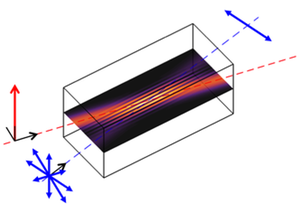Using Plasma to Manipulate Light
Manipulating the polarization of light—the direction of its electric field—is critical in many optical experiments, but advanced lasers are so powerful that they would destroy ordinary polarizing devices. Researchers now show theoretically that a beam’s polarization can be changed by combining it with another beam inside a plasma. A powerful laser would damage ordinary optical equipment by ripping electrons out of the atoms, but plasma is “already broken” in this way and isn’t further damaged by intense beams, like those used in the quest for fusion energy.
Researchers at the National Ignition Facility at Lawrence Livermore National Laboratory in California are trying to generate fusion by compressing a fuel pellet with pulses from enormous lasers. For several years they have controlled these beams in part with laser-induced structures in plasma that act as high-power mirrors. For additional control, Pierre Michel and his colleagues at Livermore wanted to manipulate the polarization of these intense beams. He says that polarization control might also be useful for the new generation of compact electron accelerators that are currently in development, since they also involve laser generated plasma.
The researchers used theory to study what happens to a “probe” beam in a plasma when it overlaps with a strong “pump” beam traveling in nearly the same direction within a horizontal plane. The field of either beam alone constantly pushes and pulls the plasma’s electrons and ions, but because it is continually and rapidly reversing direction, there is no average force. When both beams are present, however, they interfere in the side-to-side (transverse) direction and create nodes and antinodes—fixed regions of maximum and minimum electric field strength. The periodic spatial variation of the electric field induces a persistent variation of the plasma density. The probe beam helps to create this density variation, but at the same time, the beam’s properties are affected by it.
The team describes two ways to use the density waves to modify the probe beam’s polarization. In the first scheme, the pump frequency is chosen so that the combined light wave excites a natural wave in the plasma, similar to a sound wave. The analysis predicts that as the probe beam moves through this plasma density wave in the presence of the pump beam, photons from the probe will convert to match the pump, in both frequency and direction, leaving a weakened probe beam behind. But this conversion only works if the probe and pump polarizations are parallel. Any probe light with perpendicular polarization passes through unchanged, so the plasma structure acts like a traditional polarizing filter.
In the second scheme, the pump and probe are chosen to have the same frequency. The resulting static plasma density variation turns out to slow down vertically polarized probe light compared with horizontally polarized probe light. This polarization-dependent speed can be used to rotate the polarization angle or to interchange light that is linearly polarized (fixed polarization direction) with light that is circularly polarized (rotating polarization). Less powerful beams are routinely altered in this way using devices called wave plates, which are made from anisotropic crystals.
The new theoretical ideas are expected to be tested experimentally early next year, Michel says. The “top-notch” Livermore team is well positioned to evaluate the new devices, says Dustin Froula of the University of Rochester in New York State. “It’s certainly not easy.” He adds that, with the growing understanding of laser-plasma interactions in recent years, “we can begin to engineer their effects into our science applications.”
This research is published in Physical Review Letters.
–Don Monroe
Don Monroe is a freelance science writer in Murray Hill, New Jersey.







